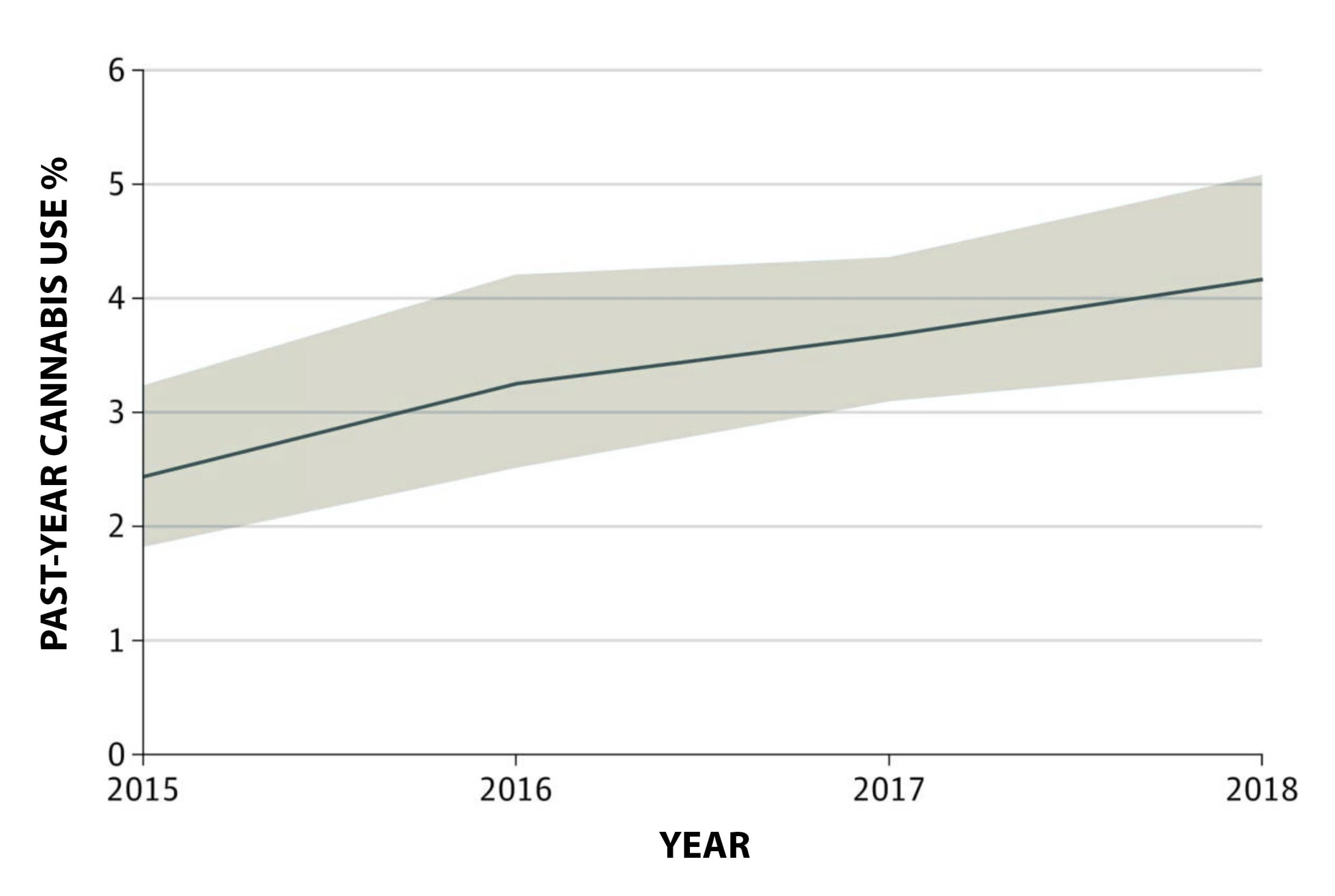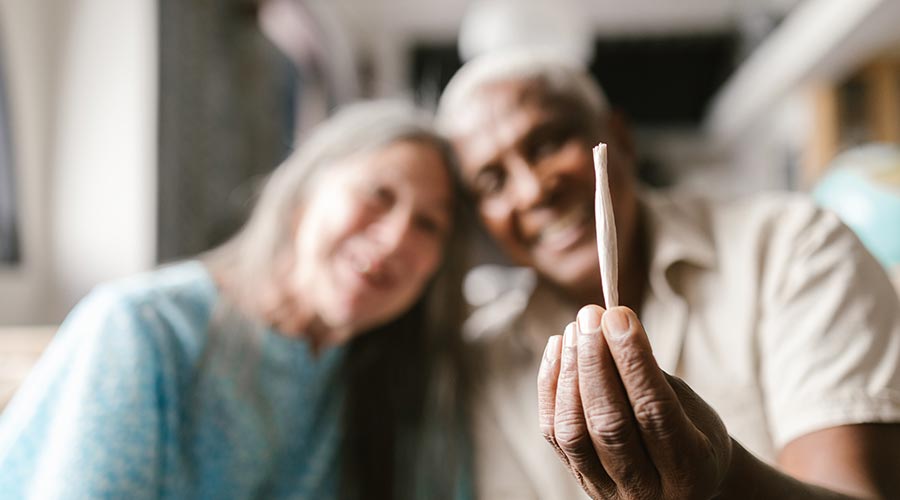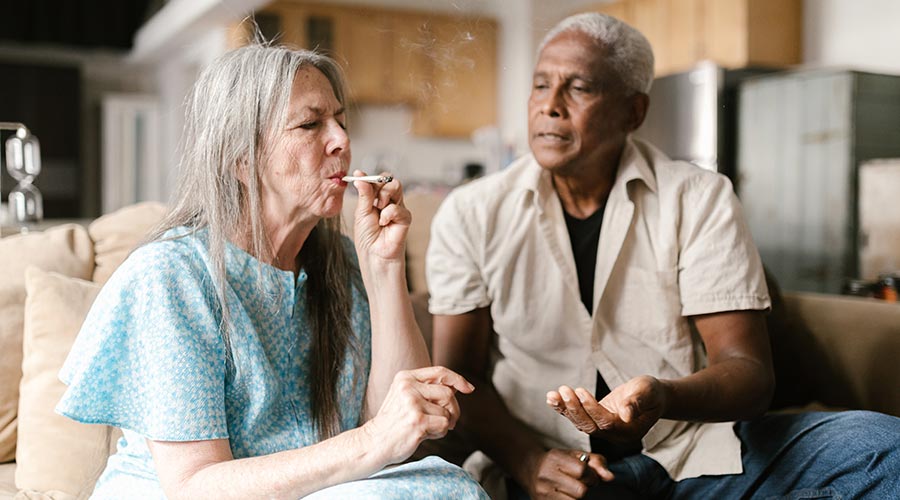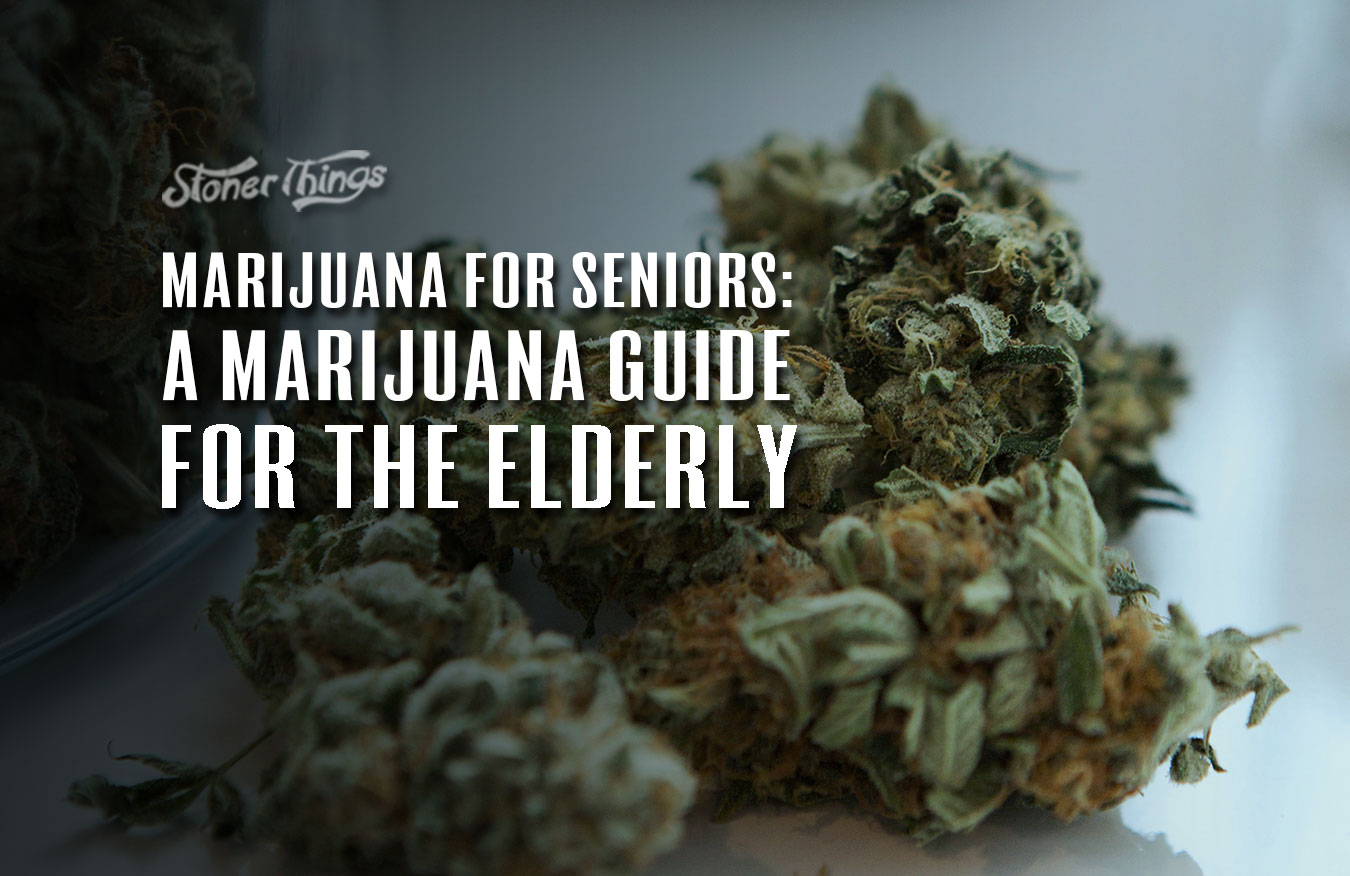Older folks, aka “seniors” over 65, are using cannabis in increasing numbers. In fact, cannabis consumption by this demographic has doubled since 2015. What accounts for this? Are there health impacts? Are they good or bad? Why are seniors turning to the devil’s lettuce? Let’s dig a bit deeper into the trends and more general cannabis information for seniors — including potential health repercussions, the rationale for use, safety considerations, consumption methods, and the benefits.
First off, let’s cover the basics. Marijuana and hemp are the same plant, i.e., cannabis. Marijuana was a term coined during the black market days when cannabis was considered a street drug. We’ve learned a lot since then. They’re the same plant . . . but different. Let’s explore that some more.
The difference between “marijuana” and “hemp” is in the varying levels of various cannabinoids and terpenes, both of which are found in cannabis. However, cannabis in “marijuana” form has psychoactive effects, and that’s due to the higher concentration of THC. But marijuana also contains CBD and minor cannabinoids. On the flip side, we have hemp: same plant, different ratios of cannabinoids and terpenes. Hemp is the government’s name for cannabis that has low THC levels (per the feds, no more than 0.3%) and contains higher levels of CBD and minor cannabinoids than the version of the plant we call marijuana. Both produce cannabinoids. Both produce terpenes. It’s the varying percentage of cannabinoids that separates what we might call pot vs. hemp. No matter the percentage of cannabinoids, they’re both technically cannabis.
How many elderly people use cannabis?
In a recently released scholarly paper, co-authors Joseph Palmer, associate professor of population health at NYU Grossman School of Medicine, and Dr. Benjamin Han, assistant professor of geriatric medicine and palliative care (also at NYU Grossman School of Medicine) analyzed data from the National Survey on Drug Use and Health. This nationally representative survey included 15,000 people, not in residential facilities.
The result? Cannabis use by people over 65 years has more than doubled from 2006-2015 and doubled again from 2015-2018. Let’s look at specifics:
- In 2006, 0.4% of seniors over 65 reported using cannabis.
- In 2015, 2.4% of seniors over 65 reported using cannabis.
- In 2018, 4.2% of seniors over 65 reported using cannabis.


Within those results, it’s worth mentioning some notable trends among use of cannabis for seniors. Cannabis use among women over the age of 65 is increasing. There is an uptick for those with higher income levels and those with pre-existing mental health problems. More racial and ethnic minorities are consuming, too. Interestingly, cannabis use among older adults with diabetes is up. However, there is no medical correlation per se between cannabis use and diabetes management. While marijuana is considered medicine for serious health issues by many advocates, with this demographic, however, the increase in cannabis use tends to be by those that do not have chronic medical conditions.
One notable trend is that older adults that use alcohol are also consuming cannabis simultaneously. In fact, the International Journal of Drug Policy published a 2019 Washington state study of trends involving combined alcohol and cannabis use that showed a marked increase in adults 50 years and older.


What’s the reason for these trends? On the one hand, the stigma attached to marijuana use is getting lower by the minute as more states legalize pot. On the other hand, the increase in legalization means more interest from a medical perspective in consuming marijuana. In fact, a recent poll revealed that 94% of Americans support legal access to medical marijuana. Correspondingly, most states have some variation of legal access to cannabis. Even the 38-million member strong AARP (American Association of Retired Persons) has publicly supported medical marijuana use for older adults.
Is cannabis use safe for elderly people?
First and foremost, is it safe for older adults to consume cannabis? Yes.
Granted, cannabis with THC above 0.3% is still a Schedule 1 drug per the feds. But make no mistake; you can consume cannabis without the heady effects. Cannabis high in CBD (i.e., hemp) may provide physical and mental relief from various ailments. But if you want to get lifted with some THC, you can go that route too.
Generally speaking, there are some concerns about whether or not cannabis use in older folks is safe. Specifically:
- Interaction with other medications: millions of people use cannabis regularly with limited information on how it may interact with their current medication regimen. A New England Journal of Medicine study cautioned, “Older adults with coexisting chronic medical conditions who use marijuana may be at risk for cognitive changes, falls, and interactions with prescription medications.”
- Physiologic response: older adults may respond differently to cannabis than a young buck in their early 20’s. For example, liver and kidney function may be impaired in older adults, which changes their ability to metabolize the medication. That means that those edibles with 20mg of THC — which are metabolized by the liver, by the way — will affect older folks differently than younger adults. Likewise, older adults on blood thinners that use cannabis might be increasing the drug’s effects. Suppose you’re on Warfarin or Coumadin and use cannabis regularly. In that case, you could end up with a situation on your hands in the case of a fall or other injury. Similarly, anti-HIV medications can amplify the psychoactive effects of cannabis. The best course of action? Discuss cannabis use with your physician and modify medicines as needed.
- Dosage: Dr. Joseph J. Morgan, Dean’s Professor and faculty member of the University of Sciences’ medical marijuana certification course, notes any risks involved with consuming low doses of cannabis (up to 10mg of cannabinoids) for seniors is minimal. Generally speaking, consuming 60 mg per day is considered a high cannabinoid dose in older adults. Anything below that threshold is unlikely to interact negatively with pharmaceutical prescription drugs.
- Side effects: while reported adverse side effects were minimal, seniors using cannabis may experience dizziness, which poses a risk of falling. To mitigate that, doctors recommend drinking plenty of water, and reducing opioids, sleeping pills, benzodiazepines, and alcohol. While cannabis use isn’t as innocuous as drinking coffee, it’s nearly impossible to overdose on cannabis. An unintended yet positive side effect of cannabis use for older adults is the role it plays in reducing and/or ceasing opioid use. An increasing number of studies reveal the impact cannabis has on reducing the need for opioids and other pain-relieving drugs. We’ll cover that one in more detail in a minute. Read on.
How can elderly people benefit from cannabis use?
Are there benefits for older adults to use cannabis? The answer is yes, and there’s data to back that up. Seniors may benefit the most (when compared to other age groups) by using cannabis. How? Cannabis may positively affect common aging issues like inflammation, pain, disrupted sleep cycles, and more. Some older adults explored cannabis use after determining the hefty side effects from their prescribed medications were reducing their quality of life.
Medical marijuana for seniors may be helpful for those seeking relief from neuropathic pain, arthritis, sleep issues, and run-of-the-mill aches and pains from old injuries. The added plus? Minimal side effects (if any), sweet relief from chronic ailments, and a newfound sense of well-being.
On October 7, 2020, University of California San Diego School of Medicine researchers published an online study in the Journal of the American Geriatrics Society. The research showed that older adults use cannabis for medical purposes, primarily to seek relief from common health issues that include pain, sleeping problems, anxiety, and depression.


Another benefit? Reduction in opioid use and/or dosage. In the Israel study mentioned earlier, the surveyed medical cannabis patients (18.1%) reported declines in their opioid use or dose. That’s pretty notable. In essence, cannabis use may improve existing, chronic health conditions that may negatively impact older adults’ quality of life. This extends to regular prescribed medication use, which may have adverse effects on a patient’s gut, liver, kidneys, and more.
Researchers need more evidence-based research to fully understand and compare cannabis to the current medications in use related to various health conditions. Research topics would include how different cannabis formulations and dosages can treat the common health conditions in older adults and maximize the overall health benefit while minimizing ill effects. In the end, researchers hope to answer the question, is cannabis a safer alternative to current pharmaceutical treatments? Could cannabis use reduce the need for multiple medications? What conditions is cannabis most effective in treating?
Which are the best cannabis consumption methods for seniors?
Before we talk about the best consumption methods of cannabis for seniors, let’s backtrack a little bit. In a 10-week study by the Medicine for Seniors Clinic at UC San Diego Health, researchers found that over half (61%) of participating patients started using cannabis after age 60. That means that despite stereotypes that baby boomers were all pot-smoking hippies in the ’60s, this is a unique group new to cannabis use. That distinction is interesting because, in the UC San Diego Health study, the patients used cannabis via topical application rather than smoking or ingesting it.
There are pros and cons to each cannabis consumption method. It’s a matter of personal preference, the type of relief sought, and more. Let’s check out the most popular ways to use cannabis and why.
- Smoking: lighting up some cannabis flower is the most popular form of consumption for many, but it’s the third most popular consumption method for seniors. Smoking flower is cost-effective and convenient. It’s easy to manage dosage since the effects are almost instantaneous. Smoking cannabis may be harmful to folks with lung disease, compromised pulmonary function, or respiratory symptoms.
- Vaping: after the EVALI scare of 2019, vaping concentrated oil took a dive in terms of popularity as lung issues popped up and the CDC started investigating the root cause (additives, primarily in black-market cartridges). However, you can vape sans oil with whole flower vaporizers. This method is easier on the lungs than smoking. Still, it requires the consumer to purchase and use a device in addition to the flower.
- Dabs: while dabbing is considered a clean way to consume cannabis, it’s not without risk. Dabs are very potent. Only a small amount is needed. Side effects include increased heart rate and paranoia. Some people don’t want an intensive high. Dabbing requires a dab rig, which might be too much of a hassle for some. The good bit about dabbing is the taste; with the concentration of terpenes, you get to experience some tasty flavor profiles. There’s even an Instagram account called ‘Elderly Who Dab.’
- Edibles: consuming cannabis via edibles is the most popular consumption method by seniors. Commercially produced edibles are consistent with dosage, have serving sizes clearly indicated, and the long duration of effects (from 4-8 hours) can be appealing to those with chronic health conditions. On the other hand, homemade edibles can have wildly fluctuating dosages, which can produce unintended highs. Edibles containing CBD are a popular choice for some; they want the health benefits and relief without feeling like they’re flying to Mars.
- Tinctures: a variation of edibles, tinctures are produced by dissolving plant matter in alcohol. Cannabis tinctures contain all the various compounds and are similar to concentrates but with one big difference. Tinctures use alcohol rather than solvents, and tinctures aren’t filtered. Tinctures have a quick onset and allow the user to adjust the consumption dosage easily. Most tinctures are vegan and don’t include sugar, gluten, etc. Tinctures may cost more than other products, so if that’s a concern, shop around. You can make your own tinctures, too, if you want. Just note that the dosage might not be accurate.
- Topicals: this is the second most popular way to use cannabis by seniors. Topicals may provide localized pain relief and help with muscle soreness, tension, and inflammation. While most topical use won’t get you high and cannot enter the bloodstream, transdermal patches can. Pay attention to product labels. You can create your own topicals, too, which may be a fun activity with beneficial side effects.
How elderly people can get marijuana
If you want to obtain marijuana, you can get it from either a recreational or medical dispensary. If recreational use is not yet legal in your state, applying for a medical marijuana card is your best course of action. The first thing you should do is check up on the qualifying conditions and rules specific to your state. For example, getting a PA medical marijuana card is possible for a long list of qualifying conditions, while other states are more restrictive.
With the increased popularity and availability of cannabis products, more older adults will likely start using cannabis or cannabis-based products regularly. Considering the growing number of studies that highlight the role cannabis can play in reducing or eliminating the need for prescribed pharmaceutical drugs, older adults may find more benefits than ever from cannabis use.













